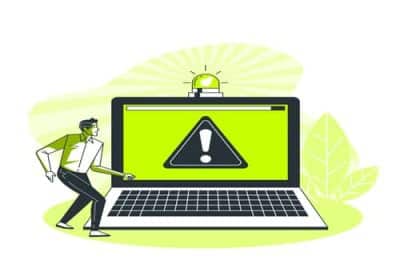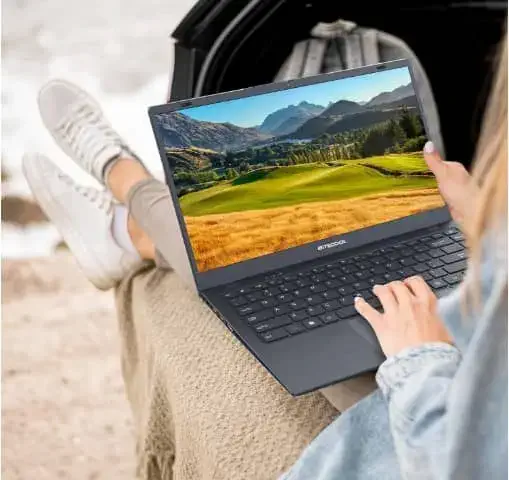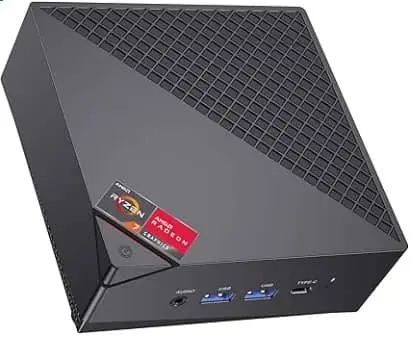
If your laptop is frozen and unresponsive, it can be frustrating, but there are several steps you can take to resolve the issue. Follow these troubleshooting steps to fix a laptop frozen:
Wait and be patient: Sometimes, the system may be overloaded with tasks or updates, causing temporary unresponsiveness. Give your laptop a few minutes to see if it resolves itself. During this time, avoid repeatedly pressing keys or clicking the mouse, as it may further delay the recovery process.
How To Fix Laptop Frozen:
1.Force restart:(To Fix Laptop Frozen)
Is your laptop frozen and refusing to respond? Don’t panic! A force restart can be your knight in shining armor, rescuing you from the clutches of a laptop frozen screen. By employing this simple yet powerful method, you can regain control of your device and bid farewell to those frustrating freezes. To initiate a force restart, start by locating the power button on your laptop. Follow these step-by-step instructions to perform a force restart effectively:

Step By Step Process to Force restart
- Press and Hold: Firmly press and hold down the power button on your laptop for approximately 10 to 15 seconds. This sustained press will ensure a complete shutdown of your laptop frozen.
- Release and Wait: After holding the power button, release it and patiently wait for a few moments. This brief pause allows any residual charge or temporary glitches to dissipate from the system.
- Power Up: Now it’s time to revive your laptop! Press the power button again to turn on your device. You will soon witness the glorious sight of your laptop coming back to life, free from the shackles of freezing.
Remember, a force restart should be used sparingly and as a last resort. Prioritize saving your work and closing applications correctly whenever possible to avoid potential data loss. In case your laptop continues to encounter frequent freezing episodes even after performing force restarts, it is advisable to consult a professional technician who can diagnose and resolve any underlying hardware or software issues causing the problem.
Stay in control of your laptop’s performance by employing these unique force restart techniques whenever the need arises. Enjoy uninterrupted productivity and bid farewell to those bothersome freezes with these quick and effective solutions.
2. Close unresponsive applications To Fix Laptop Frozen
Dealing with unresponsive applications on your laptop can be a frustrating experience, often leading to system slowdowns or freezes. However, fear not, as there’s a simple and effective solution at your fingertips: closing unresponsive applications, through this your laptop frozen problem may be solved.
By promptly shutting down these misbehaving programs, you can regain control of your laptop’s performance and restore smooth functionality. Let’s explore step-by-step instructions on how to close unresponsive applications and bring harmony back to your laptop.

Step By Step Process to Force restart
- Identify Unresponsive Applications: Start by identifying the applications that have become unresponsive. These are typically the ones that are not responding to your commands, causing delays or freezing your laptop. Take note of these troublesome applications to focus on closing them one by one.
- Task Manager to the Rescue: Launch the Task Manager by simultaneously pressing the “Ctrl,” “Shift,” and “Esc” keys on your keyboard. Alternatively, you can right-click on the taskbar and select “Task Manager” from the context menu.
- End Task: Once the Task Manager opens, navigate to the “Processes” or “Applications” tab (depending on your operating system). Look for the unresponsive application(s) you noted earlier. Select the application(s) and click on the “End Task” or “End Process” button. Confirm any prompts that appear.
- Wait and Confirm Closure: Give the system a few moments to close the unresponsive application(s). The Task Manager will indicate when the process is terminated. If the application doesn’t close, you may see a “Not Responding” label next to it. In such cases, right-click on the application and choose “End Task” once again to force it to close.
- Repeat if Necessary: If you have multiple unresponsive applications, repeat the process of selecting and closing them until you’ve addressed all the problematic programs.
- Enjoy Smooth Functionality: After successfully closing the unresponsive applications, you’ll notice an immediate improvement in your laptop’s performance. The system should become more responsive and stable, allowing you to continue your tasks without interruptions.
By following these step-by-step instructions, you can swiftly close unresponsive applications and restore harmony to your laptop. Remember to save your work in other open applications before closing them to avoid any potential data loss. Keep your laptop running smoothly by promptly dealing with unresponsive programs, ensuring a productive and hassle-free computing experience.
3. Check for overheating To Fix Laptop Frozen
Overheating is a common issue that can hamper the performance and longevity of your laptop. If you suspect your laptop is running too hot, it’s essential to take immediate action to prevent potential damage.
By checking for overheating and implementing effective cooling measures, you can ensure optimal performance and prolong the lifespan of your device. Let’s explore step-by-step instructions on how to check for overheating on your laptop, through this your laptop frozen problem may be solved.
Step By Step Process to Check for Overheating

- Physical Examination: Start by physically examining your laptop for signs of overheating. Place your hand near the laptop’s vents or underside to feel for excessive heat. If the laptop feels unusually hot to the touch, it may be an indication of overheating.
- Use Monitoring Software: Install temperature monitoring software specifically designed for laptops. These programs can provide real-time temperature readings for various components, such as the CPU and GPU. Popular software options include HWMonitor, Core Temp, or SpeedFan.
- Monitor Temperature Readings: Launch the temperature monitoring software and keep an eye on the temperature readings displayed. Pay close attention to the CPU and GPU temperatures, as they tend to generate the most heat. If the temperatures consistently exceed the manufacturer’s recommended limits, your laptop may be experiencing overheating.
- Clean Vents and Fans: Over time, dust and debris can accumulate in the laptop’s vents and fans, obstructing airflow and contributing to overheating. Use compressed air or a soft brush to carefully clean the vents and fan openings, removing any accumulated dust.
- Elevate and Ventilate: Ensure proper airflow around your laptop by elevating it on a cooling pad or using a laptop stand. This helps prevent heat buildup by allowing air to circulate freely. Additionally, avoid using your laptop on soft surfaces such as beds or couches, as they can block vents and impede airflow.
- Manage Performance: If your laptop consistently runs hot, consider adjusting the power settings or using software tools to manage the performance. Lowering the maximum processor state or using power-saving modes can help reduce heat generation, through this your laptop frozen problem may be solved.
- Consult a Professional: If your laptop continues to experience overheating issues despite these measures, it’s advisable to seek assistance from a professional technician. They can inspect the internal components, apply thermal paste, or perform other necessary maintenance tasks to alleviate the overheating problem, through this your laptop frozen problem may be solved.
By following these step-by-step instructions, you can effectively check for overheating on your laptop and implement measures to keep it cool. Regular maintenance and proper airflow are key to preventing overheating-related issues and ensuring the optimal performance and longevity of your valuable device.
4. Update drivers and operating system To Fix Laptop Frozen
Outdated or incompatible drivers and software can lead to system instability. Update your laptop’s drivers and the operating system to the latest versions available. Visit the manufacturer’s website or use the automatic update feature provided by your operating system.
A laptop frozen can be a frustrating experience, often caused by outdated drivers or an outdated operating system. However, there’s good news! By keeping your drivers and operating system up to date, you can effectively resolve freezing issues and unlock smooth performance on your laptop. In this guide, we’ll walk you through the step-by-step process of updating drivers and your operating system to bring your laptop back to life.

Step By Step Process to Update drivers and operating system:
- Identify Outdated Drivers: Start by identifying outdated drivers on your laptop. You can manually check for updates by visiting the manufacturer’s website for each component, such as the graphics card, network adapter, or sound card. Alternatively, you can use driver update software, such as Driver Booster or Driver Easy, to automate the process and identify outdated drivers.
- Download and Install Driver Updates: Once you have identified the outdated drivers, download the latest versions from the manufacturer’s website or via the driver update software. Follow the instructions provided by the manufacturer or the software to install the updated drivers. It’s important to install one driver at a time and restart your laptop after each installation to ensure proper integration, through this your laptop frozen problem may be solved.
- Windows Update: To update your operating system, utilize the built-in Windows Update feature. On Windows 10, go to “Settings” and select “Update & Security.” Click on “Check for updates” to scan for available updates. If updates are found, click on “Install” and allow the process to complete. Restart your laptop if prompted.
- Mac Update: If you are using a Mac, click on the Apple menu and select “System Preferences.” Choose “Software Update” to check for available updates. If updates are available, click on “Update Now” and follow the on-screen instructions. Restart your laptop if prompted, through this your laptop frozen problem may be solved.
- Repeat and Stay Updated: It’s crucial to regularly check for driver updates and operating system updates to ensure optimal performance and security. Set a reminder to check for updates monthly or enable automatic updates to streamline the process.
By following these step-by-step instructions, you can update drivers and your operating system, addressing the underlying causes of a laptop frozen. Enjoy a smoother and more responsive computing experience as you unlock the full potential of your device. Remember to keep your drivers and operating system up to date to stay ahead in terms of performance, stability, and security.
5. Scan for malware To Fix Laptop Frozen
Malicious software can also cause system freezes. Run a thorough scan using a reliable antivirus or antimalware program to detect and remove any potential threats. Ensure that your antivirus software is up to date.
Malware can wreak havoc on your laptop, causing freezing, sluggishness, and other undesirable issues. If you suspect that malware might be the culprit behind your laptop frozen, fear not! By conducting a thorough malware scan, you can eliminate these digital invaders and restore your laptop’s performance. In this guide, we’ll walk you through the step-by-step process of scanning for malware to free your laptop frozen.

Step By Step Process to Update drivers and operating system:
- Install Reliable Antivirus Software: Begin by installing reputable antivirus software on your laptop. Choose a well-known program such as Avast, Norton, or Bitdefender, and ensure it’s up to date. Having updated antivirus software provides a strong defense against malware threats.
- Perform a Full System Scan: Launch the antivirus software and initiate a full system scan. This comprehensive scan will thoroughly examine all files, folders, and processes on your laptop for any traces of malware. Be patient, as the scan may take some time to complete.
- Quarantine or Remove Detected Malware: Once the scan is finished, review the scan results. If any malware is detected, follow the prompts to quarantine or remove the infected files. Quarantining isolates the malware, preventing it from causing further harm, while removal eradicates it from your system.
- Update Operating System and Applications: After removing the detected malware, it’s crucial to update your operating system and applications. Malware often exploits vulnerabilities in outdated software. By keeping your system and applications up to date, you strengthen your defenses against future malware attacks.
- Enable Real-Time Protection: Enable real-time protection within your antivirus software. This feature actively monitors your system, providing an additional layer of security by detecting and blocking malware in real-time.
- Regular Scans and Safe Browsing Practices: Make a habit of performing regular malware scans on your laptop. Schedule automatic scans or set reminders to ensure ongoing protection. Additionally, practice safe browsing habits by avoiding suspicious websites, refraining from clicking on unknown links, and being cautious with email attachments.
By following these step-by-step instructions, you can effectively scan for malware and liberate your laptop frozen from their clutches. Enjoy a secure and smooth computing experience as you eliminate malware threats and safeguard your valuable data. Remember to keep your antivirus software updated and practice safe browsing habits to minimize the risk of future malware infections.
6. Remove unnecessary programs To Fix Laptop Frozen
Unwanted or resource-intensive programs can cause system freezes. Uninstall any unnecessary software or applications that you rarely use. To do this, go to the Control Panel (Windows) or the Applications folder (Mac) and uninstall any programs that you no longer need.
Is your laptop feeling sluggish and frozen? It’s time to declutter and remove unnecessary programs that might be weighing down your system. By eliminating these digital deadweights, you can free up valuable resources and restore your laptop’s performance. In this guide, we’ll provide you with step-by-step instructions on how to remove unnecessary programs and revitalize your laptop frozen.

Step By Step Process to Remove unnecessary programs:
- Evaluate Installed Programs: Start by evaluating the programs installed on your laptop. Open the Control Panel (on Windows) or go to “Applications” (on Mac) to access the list of installed programs. Take a critical look at each program and determine if it’s necessary for your daily use or if it’s rarely used.
- Uninstall Unnecessary Programs: Identify the unnecessary programs that you no longer need or rarely use. Right-click on each program and select “Uninstall” (on Windows) or drag the program to the Trash (on Mac). Follow the prompts to complete the uninstallation process. Repeat this step for all the unwanted programs.
- Utilize Uninstaller Software: Consider using uninstaller software to simplify the process of removing unnecessary programs. Programs like Revo Uninstaller (for Windows) or App Cleaner (for Mac) can help you thoroughly remove leftover files and registry entries associated with uninstalled programs.
- Remove Bloatware: Many laptops come pre-installed with bloatware—software that is often unnecessary and can slow down your system. Check for any bloatware programs that you don’t use and uninstall them using the same method described earlier.
- Regular Cleanup: Make it a habit to regularly review and remove programs that are no longer needed. This practice helps keep your laptop clutter-free and ensures optimal performance over time.
By following these step-by-step instructions, you can remove unnecessary programs and give your laptop frozen a fresh start. Experience improved speed and responsiveness as you free up system resources. Remember to exercise caution when removing programs and double-check that you’re not uninstalling any essential software. Enjoy a streamlined and revitalized laptop that is ready to meet your computing needs.
7. Check hardware components To Fix Laptop Frozen
If the issue persists, it may indicate a hardware problem. Check if any external devices connected to your laptop (such as USB drives or external hard drives) are causing the freeze. Disconnect them and see if the problem resolves. If not, you may need to seek professional assistance to diagnose and repair any faulty hardware components.
When you see laptop frozen, hardware issues could be the underlying cause. Conducting a thorough check of the hardware components can help you identify and address any potential problems, restoring your laptop’s functionality. In this guide, we’ll walk you through the step-by-step process of checking hardware components to resolve freezing issues and ensure optimal performance, and may be your Laptop frozen will be fixed.

Step By Step Process to Check hardware components:
- External Inspection: Begin by visually inspecting your laptop’s hardware components. Check for any visible damage, loose connections, or signs of overheating, such as dust accumulation or unusual noises. Pay particular attention to the power adapter, battery, display, keyboard, and ports.
- Run Built-in Hardware Diagnostics: Most laptops offer built-in diagnostic tools that can help identify hardware issues. Consult your laptop’s user manual or manufacturer’s website to determine the specific key combination or software required to access these diagnostics. Follow the instructions to initiate a hardware diagnostic test, which will scan and assess various components such as memory, hard drive, and CPU.
- Memory (RAM) Test: Unreliable or faulty RAM can cause freezing and performance issues. Run a memory test using software such as Memtest86+ to check for any errors or issues with your laptop’s RAM. Be sure to follow the software’s instructions carefully.
- Hard Drive Health Check: A failing or corrupted hard drive can also contribute to laptop freezing. Use disk utility software like CHKDSK (for Windows) or Disk Utility (for Mac) to check the health and integrity of your hard drive. These tools can scan for and fix any errors found.
- Check for Driver and Firmware Updates: Outdated drivers and firmware can lead to hardware conflicts and freezing. Visit the manufacturer’s website for your laptop’s components (e.g., graphics card, network adapter) to download and install the latest driver and firmware updates.
- External Devices: Disconnect any external devices connected to your laptop, such as USB devices or peripherals. Sometimes, incompatible or malfunctioning external devices can cause freezing. Restart your laptop and check if the freezing issue persists without the external devices connected.
- Seek Professional Assistance: If you’ve followed the above steps and continue to experience freezing issues, it may be necessary to consult a professional technician. They can perform in-depth hardware diagnostics, identify any underlying problems, and provide the appropriate repairs or replacements.
By following these step-by-step instructions, you can systematically check your laptop’s hardware components to diagnose and address any issues causing freezing and may be your Laptop frozen fixed. Enjoy a smooth and reliable computing experience as you unleash the power within your laptop. Remember to exercise caution and seek professional assistance if needed to ensure accurate diagnosis and resolution of hardware-related problems.
Conclusion:
Remember to save your work regularly to prevent data loss in case of a laptop frozen. If the problem persists even after following these steps, it’s advisable to contact technical support or take your laptop to a professional technician for further assistance.
If Your laptop frozen problem is until solve or laptop technician refuse to fix the laptop frozen issue or say that your laptop is dead due to laptop frozen issue so you can check the best laptop for any use and get it now by clicking this best laptop link.




Leave a Reply
You must be logged in to post a comment.